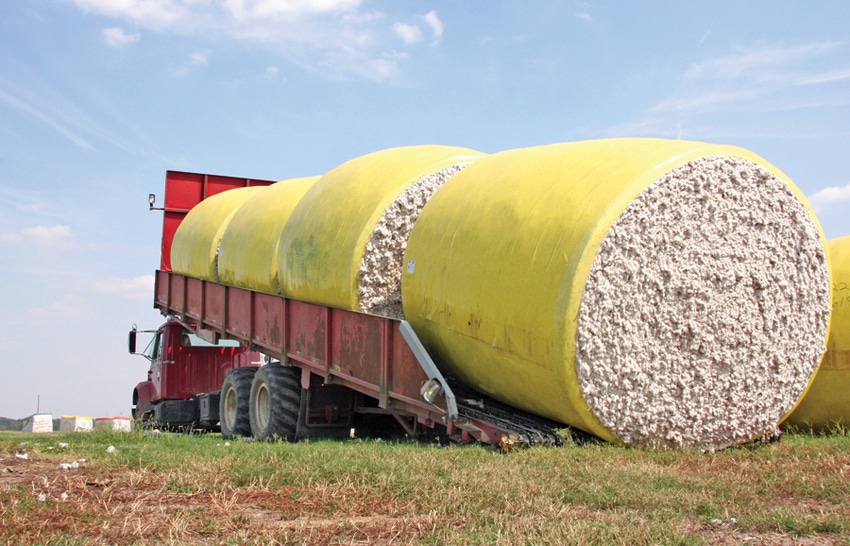
It’s hard for the cotton market to ignore nearly 74 million bales of supply. That’s one reason why cotton analysts say cotton futures dropped precipitously in early May, despite China continuing to buy cotton to add to its reserves.The 73.75 million bales in stocks was nearly 7 million bales higher than the previous year’s ending stocks, and is an all-time record high.

It’s hard for the cotton market to ignore nearly 74 million bales of supply. That’s one reason why cotton analysts say cotton futures dropped precipitously in early May, despite China continuing to buy cotton to add to its reserves.
The 73.75 million bales in stocks was nearly 7 million bales higher than the previous year’s ending stocks, and is an all-time record high.
Futures prices are starting to reflect the surplus. December 2012 futures prices had dropped from 97 cents per pound in February to around 77 cents in early May.
“Given the surplus cotton supply, and weak demand, there is a good chance that cotton will continue trading lower,” said Extension professor emeritus Carl Anderson, speaking at the Ag Market Network’s May conference call. “The price of cotton has already dropped a good $100 per bale since February, and we’re now starting to look around to see where we might bottom out and bring the market back to cotton.”
Early-planted cotton ahead of schedule
Anderson sees a potential low for December cotton futures at 70 cents, “but this morning (May 11), after these shattering price moves in the last couple of days, I’m beginning to wonder if 70 cents will hold this market.
“I would expect December futures to hopefully trade in the 70- to 88-cent range for the next several months. But I’m beginning to wonder how strong the 70-cent floor is.”
Anderson says several factors play into the new price outlook. “The economic forces of supply and demand driven by an unrealistic run up of cotton prices above $2 a pound a year ago are now driving prices far below a dollar per pound. There is simply too much cotton worldwide, and too little demand. Manmade fiber prices much lower than cotton and weak demand for higher priced cotton has cut demand for cotton very deeply.
“As we look at the U.S. role in the world market, as well as the other major players, we’re loading up with cotton that is not finding a very strong market at current prices.”
Cotton analyst Mike Stevens says USDA’s most recent estimate of world ending stocks of 73.75 million bales “is bigger than anyone has ever dreamed. In fact, the projected carryout is bigger than the entire world crop was 26 years ago. Most of the carryout comes from the cut in Chinese consumption, and there are some who think USDA may have been as much as 5 million bales too high on that number.
“We’re on a course that will eventually result in a big acreage cutback around the world. I assume this is a real wakeup to everybody. The only problem is that the markets are coming down with it.”
Anderson expects the cotton market to remain weak “until it reaches a bottom. It will then start its way up. That could happen before December, but it’s not likely.”
Anderson noted that China’s buying of cotton for its strategic reserve “has held the price up until now. China looks like it may use 41 million bales, and it looks like they’ll produce 30. China’s government has not indicated how it will manage its deficit production of about 11 million bales for 2012-13.”
On the domestic side, USDA projected U.S. ending stocks at 4.9 million bales, the largest of the last three seasons. USDA is forecasting a range for new crop cotton prices to producers between 65 cents and 85 cents.
Anderson noted that rains in Texas could add even more to USDA’s new crop production projection of 17 million bales.
“This week, (first of May), we are off to a pretty good start in west Texas, where we’ve had some widespread beneficial rains. This is very encouraging for producers in Texas, where the crop was less than 4 million bales last year. We are certainly looking at a 6 million bale crop in Texas.”
If the cotton market’s May slide was an overreaction to the downside, the market may react with bounces to the upside, Anderson noted. “If that bounce gets up there in the 80-85 cent range, it would be an opportunity for marketers to do something,” Anderson said.
Stevens sees December cotton trading in a range of 75 to 85 cents per pound. Cleveland sees a range of 74 to 87 cents, Anderson, 70 to 88 cents and Robinson, 68 to 85 cents.
About the Author(s)
You May Also Like





